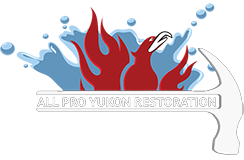Antimicrobial Restoration
Mold Remediation Services for the Whitehorse Area
What is an antimicrobial restoration technician?
Mold becomes a problem inside a home or business when there’s excessive humidity or moisture for an extended period of time. The problem can originate from sudden water releases, like a burst pipe or large spill that goes untreated, or from a chronic condition, such as a leaking roof or plumbing. Even high humidity or warm, moist air condensing on cool surfaces can trigger mold problems. It’s always best to have the mold evaluated and removed by a certified professional.
Mold can grow almost anywhere in a home or business if conditions permit. If there is visible growth on painted wall surfaces, property owners should be concerned about what may be growing on the wall’s opposite side. The environment inside the walls of a house often differ drastically from the outside and could create a perfect haven for mold. If the wall remains wet for a prolonged period, it’s almost guaranteed that the mold growth on the back side will be worse than on the front. At that point, containing the work space and removing moldy materials, followed by cleaning salvageable framing, are the best options.
Certified professionals have the training and experience to:
- Identify moisture sources
- Evaluate mold growth (visible or suspected)
- Contain damage to the smallest area possible
- Physically remove contamination
- Dry materials to ensure that mold will not return
- Perform or recommend procedures for returning property to a pre-loss condition

BSR-IICRC S520 Mold Remediation
Standard and Reference Guide for Professional Mold Remediation
The Standard was available for the first round of public review and the Reference Guide was available for informal peer review from July 05 to August 19, 2013. The second round of public review of the S520 Standard, and peer review of the S520 Reference Guide was from March 13 to April 27, 2015. All public and peer review comments submitted have been reviewed and addressed, and responses have been sent out. The S520 Consensus Body is currently reviewing the draft for final editing prior to submission to ANSI, and publication.
BSR-IICRC S520-2008 is a procedural standard and reference guide for the remediation of mold-damaged structures and contents. IICRC S520 is based on reliable remediation and restoration principles, research, and practical experience, and attempts to combine essential academic principles with practical elements of water damage restoration for technicians facing “real-life” mold remediation challenges. The S520 is written for use by those involved in the mold remediation industry, and is the result of collaboration among microbiologists and other scientists, public health professionals, industrial hygienists, remediation contractors, restoration service companies, cleaning and restoration training schools, trade associations that service the professional restoration industry, allied trade-persons, and others with related professional and practical experience.
